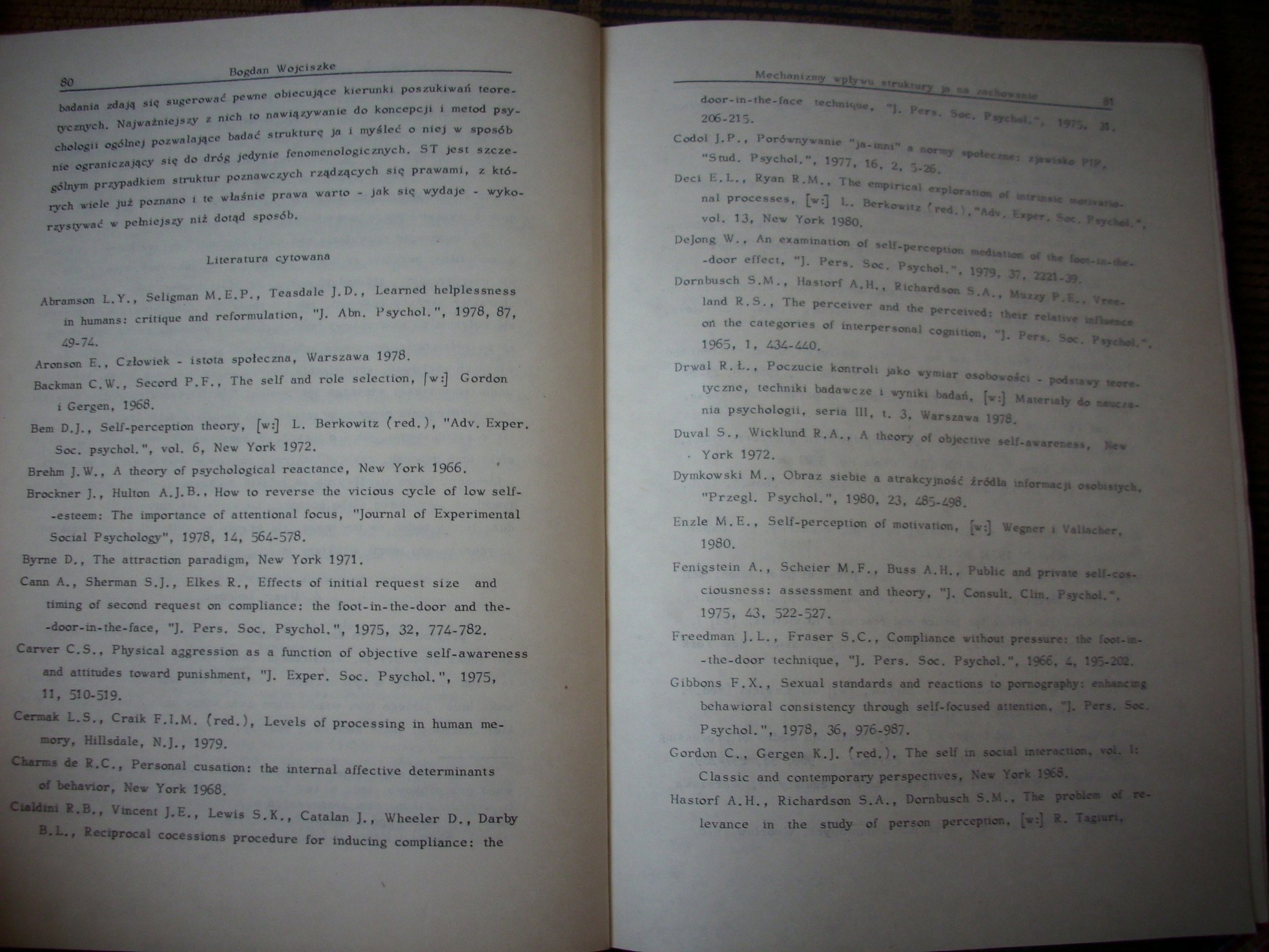Image00040

30 Bogdan Woje latko
badania zdaję Ślę sugerować pewne obiecujące kierunki poszukiwań teoretycznych. Najważniejszy z nich 10 nawiązywanie do koncepcji i metod psychologu ogólnej pozwalające badać strukturę Ja i myśleć o niej w sposób nic ograniczający się do dróg jetjynle fenomenologicznych. ST jest szczególnym przypadkiem struktur poznawczych rządzących się prawami, z któ-iych wiele Jui poznano i te właśnie prawa warto - Jak się wydaje - wykorzystywać w pełniejszy nii dotąd sposób.
Literatura cytowana
Abramson L.Y., Seligman M.E.P., Teasdale J.D., Leamed helplcssness in humans: critięue and reformulation, "]. Abn. Psychol. ", 1978, 87, 49-7-4.
Aronson E., Człowiek - istota społeczna, Warszawa 1978.
Backman C.W., Secord P.F., The self and role selection, fv:1 Gordon i Gergen, 1968.
Bem D.J., SeLf-perception theoiy, [w:] L. Berkowitz (red.), "Adv. Exper. Soc. psychol.", vol. 6, New York 1972.
Brehm J.W., A theory of psychological reactance, New York 1966.
Brockner J., Hulton A.J.B., How to reverse the vicious cycle of Iow self-•esteem: The importance of attentional focus, "Journal of Experimental Soc lal Psychology”, 1978, 14, 564-578.
Byrne D., The attraction paradigm, New York 1971.
Cann A., Sherman S.J., Elkes R., Effects of initial reąuest size and timing of second reąuest on compliance: the foot-in-the-door and the--door-in-the-face, "J. Pers. Soc. Psychol.", 1975, 32, 774-782.
Carrer C.S., Physical aggression as a functlon of objective self-awareness and attitudes toward punishment, "J. Exper. Soc. Psychol.", 1975,
11, 510-519.
Cennak L.S., Craik F.l.M. (red.), Levels of Processing in human rae-mory, Hillsdale, N.J., 1979.
Chanss de R.C., Personal cusation: the mtemal affective determinants of be ha nor, New York 1968.
■jMMR.B., Vtocent J.E,, Lewis S.K., Catalan J., Wheeler D., Darty B.L., Reciprocal cocessions procedurę for inducing compliance: the
Mechanizsy wpfr^ strwhhHy ja ja ____R
door-in-the-face technique, "J. Pers. H| nHp IjNH RH
206-215.
Codol J.P., Porównywani# "ja-mni" a normy (potoczne: zjewłel# HP#
"Stud. Psychol. "> 1977. 16, 2, 5-26,
Dęci E.L., Ryan R.M., The empiricał esploranon of wtrioeta asMgpMftMj nal processes, [w:] L. Bcrkowitz (red. , "Ada, r.»p*r, Sec, PffdMfl vol. 13, New York 1980.
Dejong W., An cxammation of self-perceptron awdiatias of At -door effect, "J. Pers. Soc. Psychol.", 1979, 37, 2221-39.
Dombusch S.M., Hasiorf A.H., Richard son S.A., Maszy P.E., Vro«-land R.S., The perceiver and the perceiwed: ibeir rei«tive hfłoeacd on the categortes of interpersonai cognitlon, "J. Pers. Soc, mAHR 1965, 1. &L-UO.
Drwal R.L., Poczucie kontroli jako wymiar osobowości - podstawy inoeo* tyczne, techniki badawcze i wyniki badań, [w:J Materiały do aawfS nia psychologii, seria 111, t. 3, Warszawa 1978.
Duval S., Wicklund R.A., A theory of objective self-awarenees, New • York 1972.
Dymkowski M., Obraz siebie a atrakcyjność źródła informacji osobistych, "Przegl. Psychol.", 1980, 23, 485-498*
Enzle M.E., Self-perception of motivanon, [w:] Wegner I Vallacher,
1980.
Fenigstein A., Scheier M.F., Buss A.H., Public and pnvaie seli-cos-ciousness: assessment and theory, "J. Consult. Clm. Pachoł.",
1975. 43, 522-527.
Freedman J. L., Fraser S.C., Compliance without pressure: tbe ioot-ir.--the-door techniąue, "J. Pers. Soc. Psychol.", 1966. >. 195-202.
Gibbons F.X.. Sexuał standards and reacnons to pornograpłiy: enhancag behawioral consistency through self-focused attention, "J. Pers. Soc. Psychol.", 1978, 36, 976-987.
Gordon C., Gergen K.J. 'red.), The self in social inieraction, voi. 1 Classic and contemporary perspecmes, New York 1968.
Hastorf A.H., Richardson S.A., Dorntusch S.M., The proWes of re-

Wyszukiwarka
Podobne podstrony:
Publikacje tematyczne będą mile widziane. Część 31 Przeprowadzenie 30 godzin zajęć przedmiotu Badani
Dodatkowe badania immunologicznew SLE • Stężenieimmunoglobulin (wzrostu
image011 (30) * Wklej Schowek Czcionka teksti ^ 11A‘ a’ ^ Zawijaj tekstB / U - Czcionka Wyrównanie S
image08 Thoma Fuchs-RosenchalMetody bezpośrednie W badaniach mikrobiologicznych, immunologicznych ko
Wulff Psychologia religii, rozdz 5 i 6 (30) 214 Rozdział 6. Korelacyjne badania religii OCENA ORI
Image00026 52 Bogdan Wojclszke prnpadku zarówno regulator (struktura ja), Jak 1 przedmiot regulowany
Depresja u dzieci i mlodzieży 9 (30) Ostatecznie powiemy, że badania i wnioski różnych badaczy zgo
30 31 (30) diagnostycznych, lecz prowadzą badania wyjaśniające, weryfikacyjne, eksperymentalne. Bada
Zbigniew Korczewski, Bogdan Pojaw a Rys. 3. Badania endoskopowe silnika turbinowego typu DR 76 i DR
Image0032�01 30 Fotochemigi atla Orh bardzo przepraszam, ale w pośpiechu opowiadania zapomniałam o w
Image0036�01 30 Kapnica vide Liąuefactorium. Kapral. Aboś to kapral czy komendę masz, co go laską bi
Image0039�01 30 a anioł, mając w pudełku lalki, zamierza wyreżyserować zabawę grzecznych dzieci. Tym
więcej podobnych podstron